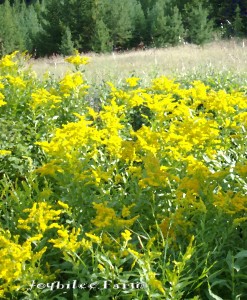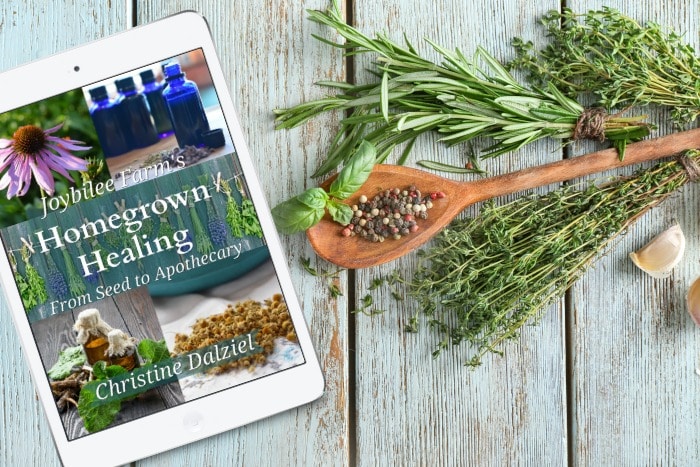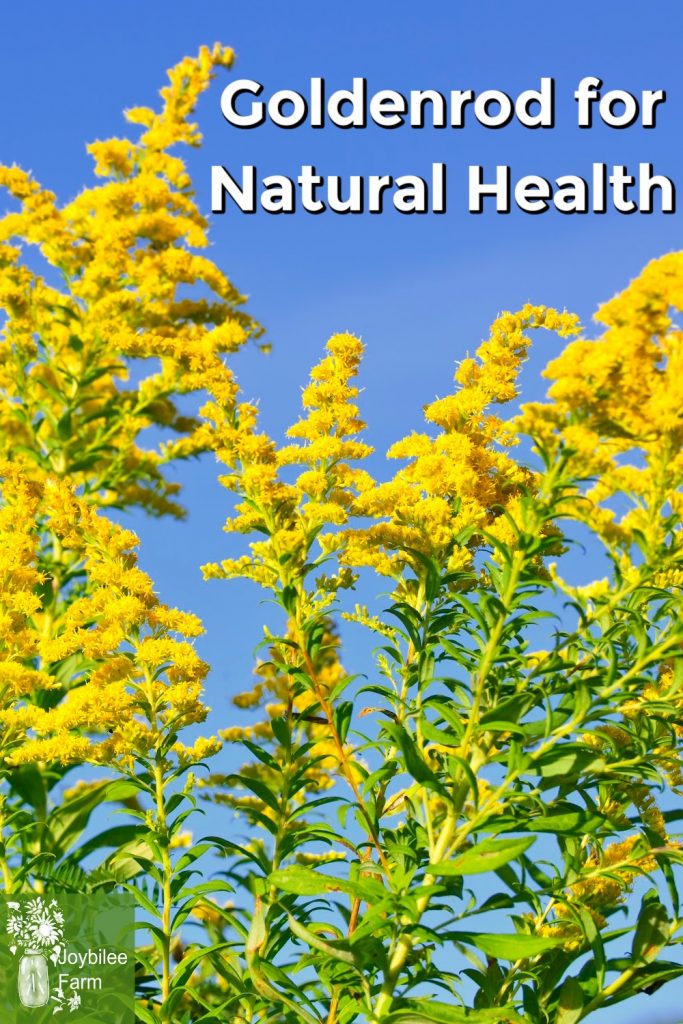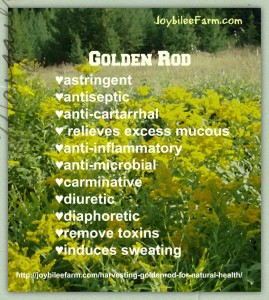Goldenrod for Natural Health
This herbal information post about Goldenrod will show you how to grow, harvest and create herbal medicines for your natural health.
In February 2013, herbal remedies and supplements became more difficult to source in Canada. At that time any natural health products that we’re unable to obtain approval from Health Canada were removed from health food stores and pharmacies. In order to maintain our personal health with natural, life giving herbs and supplements, Canadians now need to grow, harvest, and preserve their own herbs and supplements. To help you take care of your family’s health, Joybilee Farm is providing a series of herbal information posts, so that you can harvest your own herbs and create the herbal medicines that you personally need to thrive.
Canadian Goldenrod (Solidago spp.)

Goldenrod is a wildflower of waste places, pastures, and disturbed land.
Canadian Goldenrod is a well known perennial wildflower, that blooms from August through September. It is a really good bee flower and will attract bees to your garden. Natural dyers know of its golden yellow flowers and covet it for its strong, warm yellow dye, which is rich and cheerful. Its healing properties are not so well known.
Therapeutic Uses of Golden Rod
Canadian Goldenrod is astringent and antiseptic and is useful as an anti-catarrhal. It relieves excess mucous in the upper respiratory system — nose and throat. Goldenrod is also anti-inflammatory, anti-microbial, carminative, diuretic, and diaphoretic. It helps remove toxins from the body by inducing sweating and urination.
Its active ingredients include saponins, essential oil, bitter principle, tannins, flavonoids.
Goldenrod is perhaps the first plant to consider for upper respiratory catarrh, whether acute or chronic. The plant may also be usind in combination with other herbs to treat influenza. Its carminative properties point to a role in the treatment of flatulent dyspepsia. As an anti-inflammatory urinary tract antiseptic, goldenrod may be helpful in cystitis, urethritis, and similar condition affecting this system. As a gargle, goldenrod can be effective for laryngitis and pharyngitis. It may be applied externally to promote healing of wounds. (Hoffman. Medical Herbalism, the science and practice of herbal medicine. Healing Arts Press: Rochester, 2003)
Medical Herbalism: The Science Principles and Practices Of Herbal Medicine
How to grow Goldenrod:
Goldenrod is hardy to zone 3. It can grow up to 4 feet in height. Space plants on 3 feet centres. Goldenrod grows by sending up flowering stalks from the root ball. Each root will provide many flowering stocks, with cheerful yellow flowers that are attractive to bees and butterflies. You can get cultivars at a garden centre, or get a root division from a friend. Transplant them into your garden in early spring, rather than trying to grow from seed. The seeds are difficult to start. The roots are strong and once you can get it growing, you will have an easy time letting it thrive.
It thrives in average soil with only occasional watering.
When to Harvest
Harvest Goldenrod for Medicinal uses anytime in the Summer and Fall when the flowers are in bloom. Gather the above ground parts of the plant, by cutting the stem off at ground level. Use the fresh leaves and flowers to make a tincture. To preserve them dry, gather the stems with an elastic band and hang them upside down to dry, in an airy place, in the shade or away from direct sunlight. Once dry, strip the leaves and flowers from the dried stems and store them in a cool, dry place, in a glass jar, away from light.
There are several ways to tap into goldenrod’s medicinal benefits. Make a tincture if you want to take a spoonful of medicine or combine it with other medicines. Make an infusion of the dried herbs to use in tea for a cold, or if you want to use it as a basis for cough drops or syrups. Make capsules from the dried herbs to take them in pill form, a convenient way to use herbs when you are travelling.
How to make goldenrod tincture
Cut the fresh plant into 3 to 5 inch pieces and press tightly into a sterilized canning jar. Cover with vodka, using a knife along the inside of the glass jar, to release air bubbles. Cap tightly and leave in a sunny place to allow the leaves and flowers to release their medicine into the alcohol. Strain after two weeks, and bottle in an amber glass bottle. Cap tightly and store in a cool, dark place.
How to dry goldenrod for tea/infusion
To dry goldenrod, gather the flowering stems, when in bloom, but before the open flowers begin to fade. Bundle and hang upside down in an airy place, in the shade. Once the plants are fully dry, remove the dried flowers and leaves from the stalks. Discard the stocks and save the dried leaves and flowers.
Use in an infusion for urinary tract infections. Combine with yarrow, for colds or flu symptoms.
How to make capsules of goldenrod
See my instructions for using a capsule machine. Using a mortar and pestle, grind the dried goldenrod leaves and flowers and fill capsules, using a capsule machine. About 2 tbsp of ground goldenrod will fill 24 capsules. These are convenient for treating a urinary tract infection.
Safety considerations:
Goldenrod may cause allergic reactions in people who are sensitive to plants in the Asteraceae family.
Preparations and Dosage:
Tincture dosage is 2 to 4 ml three times a day (1:5 in 40%)
Infusion – 1 cup of boiling water over 2 to 3 tsp of dried herb, infuse for 10 to 15 min. Drink 3 times a day.
Commission E recommends a daily dosage of 6 to 12 grams of herb, or equivalent.
Useful resources:
The Capsule Machine, To fill “00“ size capsules
Capsule Filler Kit + 1000 Gelatin Capsules – Capsule Machine Size ’00’
The Herbal Medicine-Maker’s Handbook: A Home Manual
Prescription for Herbal Healing: An Easy-to-Use A-Z Reference to Hundreds of Common Disorders and Their Herbal Remedies
Medical Herbalism: The Science Principles and Practices Of Herbal Medicine
The Illustrated Encyclopedia of Herbal Remedies (Third Edition)
Learn more about using herbs for health and wellness from my Book

Homegrown Healing From Seed to Apothecary
My book Homegrown Healing From Seed to Apothecary will help you grow healing herbs in your own garden. Focusing on the easiest plants for beginners to grow, Homegrown Healing From Seed to Apothecary covers 30 plants, recommended by professional herbalists, that can be grown in the temperate zone. Initial garden preparation, garden design and harvesting tips lead the novice herbalist into early success. Choose which herbs to grow, learn how to use these herbs for your family’s health and wellness using the guidance in my book. You can find out more about this useful guide to growing more herbs and using them strategically here.






If it is native golden rod you can get the seeds but if its a selected kind you’ll want to divide the root ball. Or do a combination to ensure success.
I have honey bees and quite a lot of Golden rod growing . I would like to in the future grow long rows of goldenrod. So is it possible to collect the seeds and plant them. or should I dig up the plants and use the root ball , thank you soooo much
God has blessed me with much Goldenrod when I needed it.. thank you for your time and consideration that you have made it possible for others to retain their health…
You can use the fluffy blooms and the leaves for herbal remedies. If they looked sound when you harvested them they should be fine.